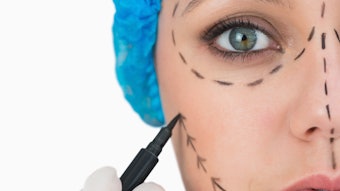
Non-invasive body contouring treatments that promise snatched jaws, slimmer thighs and firmer abs (without the endless planks), have surged in popularity post-pandemic, and generated billions of dollars in revenue for the medspa industry. But reports of potentially serious side effects, together with costly litigation against manufacturers and providers, have led to concerns about promoting these treatments.
Here’s what medspas need to know about promoting non-invasive body contouring treatments.
What Is Non-Invasive Body Contouring?
Non-invasive body contouring, also known as body sculpting, refers to using devices and procedures on the surface of the skin in order to change the shape of an area on the body.
Unlike traditional surgical procedures, which remove excess skin, or liposuction, which uses a narrow vacuum-type device to suction fat through a small incision in the skin, non-invasive body contouring does not remove skin or tissue, and thus, requires less downtime. Instead, they improve the appearance of certain areas of the body by:
- Temporarily reducing the circumference of areas of the body such as the waist or thighs.
- Temporarily reducing the appearance of small areas of fat or bulges.
- Improving the tone and firmness of certain muscles.
- Improving the appearance of cellulite.
How Does Non-Invasive Body Contouring Work?
Non-invasive body contouring treatments can be distinguished by whether they use thermal (cooling or heating tissue) or non-thermal (does not cool or heat tissue) technology to achieve the desired effect.
Thermal treatments, like cryolipolysis (also referred to as fat freezing), use cold temperatures to freeze and kill fat cells, reducing visible bulges. Other procedures, which use radiofrequency energy (RE) or intense pulsed light (IPL), heat the layer of subcutaneous fat and connective strands to temporarily improve the appearance of cellulite or reduce the circumference of the treated area. They also may cause the skin to feel or look tighter because of shrinking or increased collagen production.
Non-thermal treatments, such as pulsed magnetic fields, work by triggering small electric currents in the muscles, causing them to contract repeatedly. Over time, these treatments may improve muscle tone and firmness of traditional problem areas like the abdomen, buttocks, thighs and/or calves.
Non-invasive body contouring may also involve the use of topical creams or formulas that are massaged into areas like the thighs, hips, abdomen and buttocks, in order to minimize the appearance of cellulite or give the impression of smoother, firmer skin.
How Are Non-Invasive Body Contouring Treatments Regulated?
Non-invasive body contouring treatments may be regulated by the U.S. Food & Drug Administration (FDA) as medical devices if the product is intended for use in the diagnosis of disease or other conditions, or in the cure, mitigation, treatment or prevention of disease in man, or intended to affect the structure or any function of the body and does not obtain that effect through a chemical interaction within the body or by metabolism. In some cases that fall within the first half of this definition, the product may be regulated as a drug.
Topical creams and formulas that are strictly intended to be applied to the human body for the purpose of, “beautifying, promoting attractiveness or altering the appearance,” of the body may be regulated by the FDA as cosmetics, and subject to federal laws and regulations governing cosmetics.
Devices like those used to perform cryolipolysis or generate pulsed magnetic fields, while intended to address aesthetic concerns, are regulated by the FDA as medical devices and subject to pre-market approval. In layman’s terms, this means that the sponsor of the device must demonstrate its safety and efficacy for its intended use before marketing, distributing or offering the device for sale.
In addition to the FDA, the Federal Trade Commission (FTC), in some instances, also regulates promotional claims regarding medical devices, and requires that claims about the benefits and safety of body contouring treatments be truthful, not misleading and supported by science.
Finally, depending on where the products are manufactured and/or sold, body contouring treatments may be subject to a range of state laws.
What Are the Risks Associated with Body Contouring Treatments?
Non-invasive body contouring treatments have surged in popularity largely due to their lack of downtime, and low incidence of side effects as compared to traditional plastic surgery. However, even non-invasive treatments are not entirely without risk.
Sides effects may include pain or discomfort, redness, swelling, bruising, numbness and in rare cases, nerve damage or Paradoxical Adipose Hyperplasia (PAH), a phenomenon in which fatty tissue grows instead of shrinking in the treated area.
In addition to health risks, there are legal risks associated with promoting non-invasive body contouring treatments. While certain devices have been approved by the FDA, other treatments have never been cleared or approved by the FDA as safe or effective. Treatments may carry health risks that patients fail to appreciate since they are marketed as non-invasive. Finally, the FDA has warned that non-invasive body contouring is not intended to treat obesity, improve a person’s health or result in permanent weight loss.
These legal risks can result in costly and time-consuming litigation. In recent years, consumers have sued manufacturers of body contouring devices, alleging that the devices are defective, unsafe and inappropriate for use as designed, and resulted in injury when used as directed. Other lawsuits have alleged that manufacturers failed to adequately warn consumers of potentially severe adverse side effects.
In addition to lawsuits directed specifically at manufacturers, treatment providers have come under increasing fire with false advertising lawsuits, fueled in part by the rise of social media. These lawsuits alleged that providers offered “sham procedures” using counterfeit devices that were not FDA-authorized, that are otherwise inconsistent with how reasonable consumers interpret these terms.
Finally, in addition to costly litigation, there is the risk of regulatory enforcement against companies that make overbroad or unsubstantiated promotional claims. Both the FDA and FTC have issued warning letters to beauty manufacturers for “drug” claims as well as overbroad or unsubstantiated claims, like promising to stimulate hair growth, reduce wrinkles, prevent aging and repair skin damage.
What Are the Takeaways?
Companies should be aware of the potential for liability for promoting non-invasive body contouring treatments absent adequate substantiation.
Wherever possible, companies should:
- Avoid making claims that non-invasive body contouring treatments will result in permanent weight loss or fat elimination, “vanish” cellulite or “cure” medical conditions such as obesity.
- Use caution in describing devices or procedures as “FDA registered” or “FDA certified.” These terms are not the same thing as FDA approved, FDA authorized or FDA cleared, and may be misleading to consumers.
- Ensure that treatment providers are trained and qualified, have appropriate medical supervision, discuss any side effects or potential complications with patients and obtain informed consent before performing any treatments.
- Stay current with relevant legislation, as well as federal guidance concerning medical devices and marketing claims.
- Ensure consistency of claims and language with marketers and influencers to ensure any claims are truthful, not misleading and adequately substantiated.
- Consider asking regulatory counsel to review advertising and promotional material (including web advertising and social media).












